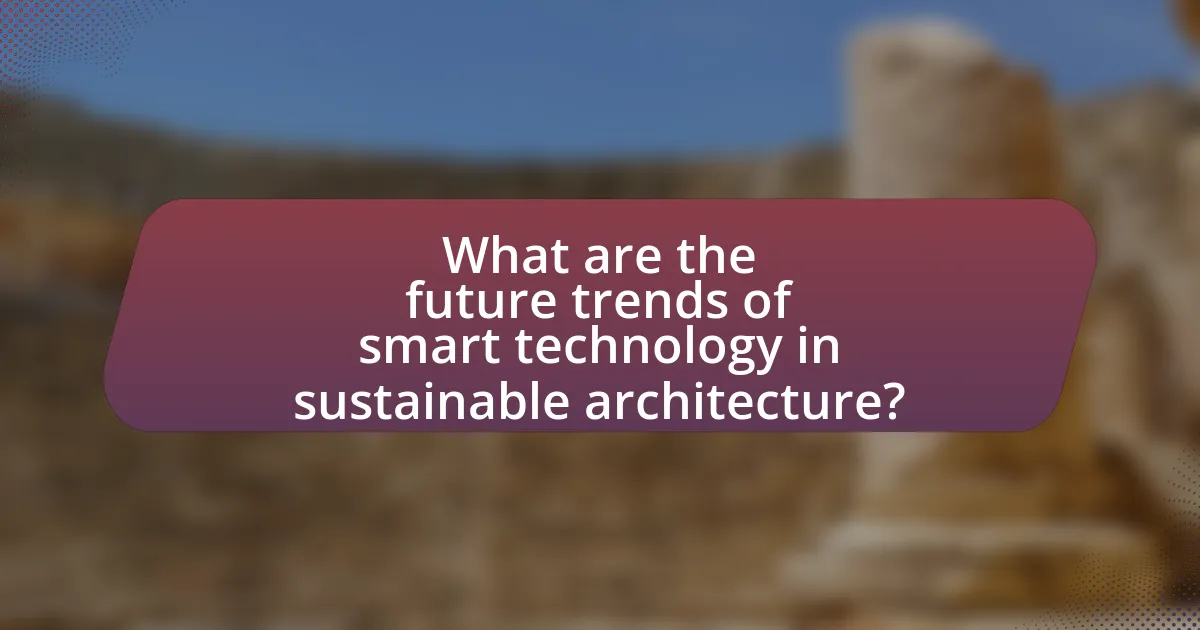Smart technology significantly enhances sustainability in architecture by optimizing energy efficiency, reducing waste, and improving resource management. Key features include automation, connectivity, and data analytics, which facilitate real-time monitoring and control of building systems. Sensors play a crucial role in energy efficiency by adjusting lighting and HVAC based on occupancy and environmental conditions. The integration of smart technologies, such as IoT devices and advanced materials, supports sustainable practices and contributes to reduced operational costs and environmental impact. Challenges such as high initial costs and interoperability issues must be addressed to maximize the benefits of smart technology in sustainable architectural design.

How does smart technology enhance sustainability in architecture?
Smart technology enhances sustainability in architecture by optimizing energy efficiency, reducing waste, and improving resource management. For instance, smart building systems utilize sensors and automation to monitor and control lighting, heating, and cooling, leading to energy savings of up to 30% according to the U.S. Department of Energy. Additionally, smart technology facilitates the use of renewable energy sources, such as solar panels, by integrating energy storage and management systems that maximize their effectiveness. This integration not only lowers carbon footprints but also promotes sustainable practices in construction and operation, aligning with global sustainability goals.
What are the key features of smart technology in architecture?
The key features of smart technology in architecture include automation, energy efficiency, connectivity, and data analytics. Automation allows for the control of building systems such as lighting, heating, and security through smart devices, enhancing user convenience and operational efficiency. Energy efficiency is achieved through smart sensors and systems that optimize energy consumption, contributing to sustainability goals. Connectivity enables seamless communication between devices and systems, facilitating real-time monitoring and management. Data analytics provides insights into building performance, allowing for informed decision-making to improve sustainability outcomes. These features collectively enhance the functionality and environmental performance of architectural designs.
How do sensors contribute to energy efficiency in buildings?
Sensors significantly enhance energy efficiency in buildings by providing real-time data on occupancy, temperature, and energy usage. These devices enable automated systems to adjust lighting, heating, and cooling based on actual needs, reducing unnecessary energy consumption. For instance, occupancy sensors can turn off lights in unoccupied rooms, leading to energy savings of up to 30%. Additionally, smart thermostats utilize temperature sensors to optimize heating and cooling schedules, which can lower energy costs by 10-20%. The integration of these sensors into building management systems allows for continuous monitoring and optimization, further improving overall energy efficiency.
What role does automation play in sustainable architectural design?
Automation plays a crucial role in sustainable architectural design by optimizing resource use and enhancing energy efficiency. Automated systems, such as smart building technologies, enable real-time monitoring and control of energy consumption, which can reduce waste and lower carbon footprints. For instance, studies show that buildings equipped with automated lighting and HVAC systems can achieve energy savings of up to 30%. Additionally, automation facilitates the integration of renewable energy sources, allowing for better management of energy production and consumption. This synergy between automation and sustainable practices leads to more resilient and environmentally friendly architectural solutions.
Why is sustainability important in modern architecture?
Sustainability is important in modern architecture because it minimizes environmental impact while promoting resource efficiency. This approach addresses critical issues such as climate change, resource depletion, and urbanization by integrating eco-friendly materials, energy-efficient systems, and sustainable design practices. For instance, buildings designed with sustainable principles can reduce energy consumption by up to 50% compared to traditional structures, as reported by the U.S. Green Building Council. Furthermore, sustainable architecture enhances occupant health and well-being through improved indoor air quality and natural lighting, which are essential for creating livable spaces.
How does sustainable architecture impact the environment?
Sustainable architecture positively impacts the environment by reducing resource consumption and minimizing waste. This design approach incorporates energy-efficient systems, sustainable materials, and water conservation techniques, which collectively lower the carbon footprint of buildings. For instance, according to the U.S. Green Building Council, green buildings can reduce energy use by 30% to 50% compared to conventional structures. Additionally, sustainable architecture often includes features like green roofs and rainwater harvesting, which enhance biodiversity and improve urban water management. These practices contribute to healthier ecosystems and promote a more sustainable urban environment.
What are the economic benefits of sustainable architectural practices?
Sustainable architectural practices provide significant economic benefits, including reduced operational costs and increased property value. By utilizing energy-efficient designs and materials, buildings can lower utility expenses, with studies indicating that energy-efficient buildings can save up to 30% on energy costs annually. Additionally, sustainable practices often lead to higher market demand; properties designed with sustainability in mind typically command a premium, with research showing that green buildings can sell for 10-20% more than conventional ones. Furthermore, sustainable architecture can attract tax incentives and grants, enhancing financial viability for developers and investors.
What challenges does smart technology face in promoting sustainability?
Smart technology faces several challenges in promoting sustainability, including high initial costs, interoperability issues, and data privacy concerns. High initial costs can deter investment in smart technologies, as many sustainable solutions require significant upfront capital, which may not be feasible for all stakeholders. Interoperability issues arise when different smart systems and devices fail to communicate effectively, leading to inefficiencies and reduced effectiveness in achieving sustainability goals. Data privacy concerns also pose a challenge, as the collection and analysis of data necessary for optimizing smart technologies can lead to apprehension among users regarding how their information is used and protected. These challenges hinder the widespread adoption and effectiveness of smart technologies in enhancing sustainability within architecture.
How can integration issues be resolved in smart building systems?
Integration issues in smart building systems can be resolved through the implementation of standardized communication protocols and interoperability frameworks. These frameworks, such as BACnet and KNX, facilitate seamless data exchange between diverse systems, ensuring that devices from different manufacturers can work together effectively. Research indicates that using these standards can reduce integration costs by up to 30% and improve system reliability, as evidenced by case studies in smart buildings where interoperability led to enhanced operational efficiency and reduced energy consumption.
What are the costs associated with implementing smart technology in architecture?
The costs associated with implementing smart technology in architecture typically range from 5% to 15% of the total construction budget. This includes expenses for advanced building management systems, sensors, automation technologies, and integration with existing infrastructure. For instance, a study by the National Institute of Standards and Technology indicates that smart building technologies can lead to energy savings of 20% to 50%, which can offset initial investment costs over time. Additionally, ongoing maintenance and software updates contribute to long-term financial considerations, with estimates suggesting annual maintenance costs can be around 1% to 3% of the initial investment.

How do specific smart technologies contribute to sustainability in architecture?
Specific smart technologies contribute to sustainability in architecture by optimizing energy efficiency, reducing waste, and enhancing resource management. For instance, smart building systems utilize sensors and automation to monitor and control lighting, heating, and cooling, leading to energy savings of up to 30% according to the U.S. Department of Energy. Additionally, smart water management systems can detect leaks and optimize irrigation, significantly reducing water consumption. Furthermore, the integration of renewable energy sources, such as solar panels with smart grid technology, allows buildings to generate and manage their own energy, promoting a reduction in carbon footprint. These technologies collectively support sustainable practices by minimizing resource use and promoting environmental stewardship.
What types of smart technologies are commonly used in sustainable architecture?
Smart technologies commonly used in sustainable architecture include building automation systems, energy management systems, smart lighting, and renewable energy integration. Building automation systems optimize energy use by controlling heating, ventilation, and air conditioning (HVAC) based on occupancy and environmental conditions, leading to energy savings of up to 30% according to the U.S. Department of Energy. Energy management systems monitor and analyze energy consumption, enabling real-time adjustments to reduce waste. Smart lighting systems utilize sensors to adjust brightness based on natural light availability, which can decrease energy usage by 40% as reported by the International Energy Agency. Additionally, integrating renewable energy sources, such as solar panels and wind turbines, allows buildings to generate their own energy, further enhancing sustainability.
How do smart grids enhance energy management in buildings?
Smart grids enhance energy management in buildings by enabling real-time monitoring and control of energy consumption. This technology allows for the integration of renewable energy sources, such as solar and wind, optimizing energy use based on demand and supply fluctuations. For instance, smart grids facilitate demand response programs, which adjust energy usage during peak times, leading to reduced energy costs and improved efficiency. According to the U.S. Department of Energy, smart grid technologies can reduce energy consumption by up to 15% in residential buildings, demonstrating their effectiveness in enhancing energy management.
What is the role of IoT in monitoring building performance?
The role of IoT in monitoring building performance is to provide real-time data collection and analysis, enabling efficient management of resources and systems. IoT devices, such as sensors and smart meters, continuously track parameters like energy consumption, temperature, humidity, and occupancy levels. This data allows building managers to optimize energy use, reduce waste, and enhance occupant comfort. For instance, a study by the International Energy Agency found that implementing IoT solutions can lead to energy savings of up to 30% in commercial buildings. Thus, IoT significantly contributes to improved operational efficiency and sustainability in architecture.
How does smart technology improve resource management in architecture?
Smart technology improves resource management in architecture by enabling real-time monitoring and optimization of energy, water, and materials. For instance, smart sensors and IoT devices track energy consumption patterns, allowing architects and builders to design more efficient systems that reduce waste. According to a study by the American Institute of Architects, buildings equipped with smart technology can achieve energy savings of up to 30%. Additionally, smart water management systems can detect leaks and optimize usage, further enhancing resource efficiency. These advancements not only lower operational costs but also contribute to sustainable building practices.
What are the benefits of smart water management systems?
Smart water management systems provide significant benefits, including improved water efficiency, reduced operational costs, and enhanced environmental sustainability. These systems utilize advanced technologies such as IoT sensors and data analytics to monitor water usage in real-time, enabling precise management and conservation efforts. For instance, a study by the American Water Works Association found that implementing smart water management can reduce water loss by up to 30%, leading to substantial savings and more sustainable water use practices. Additionally, these systems facilitate better decision-making through data-driven insights, ultimately contributing to the overall sustainability goals in architecture and urban planning.
How can smart waste management solutions reduce environmental impact?
Smart waste management solutions can significantly reduce environmental impact by optimizing waste collection and processing through data-driven technologies. These solutions utilize sensors and IoT devices to monitor waste levels in real-time, enabling more efficient collection routes and schedules, which decreases fuel consumption and greenhouse gas emissions. For instance, a study by the World Bank indicates that smart waste management can reduce operational costs by up to 30% and lower carbon emissions by 20% through improved logistics. Additionally, these systems promote recycling and waste diversion by providing analytics that help municipalities identify recycling opportunities, ultimately leading to reduced landfill use and resource conservation.

What are the future trends of smart technology in sustainable architecture?
Future trends of smart technology in sustainable architecture include the integration of artificial intelligence for energy management, the use of IoT devices for real-time monitoring of building performance, and the implementation of advanced materials that enhance energy efficiency. Artificial intelligence systems can optimize energy consumption by analyzing usage patterns and adjusting systems accordingly, leading to significant reductions in energy waste. IoT devices enable continuous data collection on factors such as temperature, humidity, and occupancy, allowing for dynamic adjustments that improve comfort and reduce resource use. Additionally, advanced materials like self-healing concrete and energy-generating facades are being developed to further enhance sustainability in building design. These trends are supported by research indicating that smart technologies can reduce energy consumption in buildings by up to 30%, demonstrating their potential impact on sustainable architecture.
How is artificial intelligence shaping sustainable architectural practices?
Artificial intelligence is shaping sustainable architectural practices by optimizing design processes, enhancing energy efficiency, and improving resource management. AI algorithms analyze vast amounts of data to identify the most sustainable materials and construction methods, leading to reduced waste and lower carbon footprints. For instance, AI-driven tools like Autodesk’s Generative Design enable architects to explore numerous design alternatives that meet sustainability criteria, thus promoting eco-friendly building solutions. Additionally, AI systems can monitor energy consumption in real-time, allowing for adjustments that minimize energy use and enhance overall building performance. This integration of AI in architecture not only supports sustainable practices but also aligns with global efforts to combat climate change and promote environmental stewardship.
What potential does machine learning have in optimizing building designs?
Machine learning has significant potential in optimizing building designs by enabling data-driven decision-making that enhances efficiency and sustainability. By analyzing vast datasets, machine learning algorithms can identify patterns and predict performance outcomes, allowing architects and engineers to create designs that minimize energy consumption and maximize resource utilization. For instance, a study published in the journal “Energy and Buildings” demonstrated that machine learning models could reduce energy use in buildings by up to 30% through optimized HVAC systems and lighting controls. This capability not only leads to cost savings but also contributes to reducing the carbon footprint of buildings, aligning with sustainability goals in architecture.
How can predictive analytics improve energy consumption forecasting?
Predictive analytics can significantly enhance energy consumption forecasting by utilizing historical data and advanced algorithms to identify patterns and trends in energy usage. This approach allows for more accurate predictions of future energy demands, enabling better resource allocation and management. For instance, a study by the U.S. Department of Energy found that predictive analytics can improve forecasting accuracy by up to 30%, leading to optimized energy distribution and reduced waste. By analyzing variables such as weather patterns, occupancy rates, and historical consumption data, predictive analytics provides actionable insights that help architects and builders design more energy-efficient structures, ultimately contributing to sustainability in architecture.
What best practices should architects follow when integrating smart technology?
Architects should prioritize user-centered design when integrating smart technology to ensure that the technology enhances the user experience and meets the needs of occupants. This involves conducting thorough research on user preferences and behaviors, which can lead to more effective and sustainable design solutions. Additionally, architects should focus on interoperability, ensuring that different smart systems can communicate and work together seamlessly, which enhances efficiency and reduces energy consumption.
Moreover, incorporating scalable solutions allows for future upgrades without significant overhauls, promoting long-term sustainability. Architects should also consider energy efficiency by selecting smart technologies that optimize resource use, such as smart lighting and HVAC systems that adjust based on occupancy and environmental conditions.
Finally, ongoing maintenance and user education are crucial; architects should provide clear guidelines for users on how to operate smart systems effectively, ensuring that the technology is utilized to its full potential. These practices collectively contribute to a more sustainable architectural approach that leverages smart technology effectively.
How can architects ensure user engagement with smart systems?
Architects can ensure user engagement with smart systems by designing intuitive interfaces that prioritize user experience and accessibility. By incorporating user feedback during the design process, architects can create systems that align with user needs and preferences, enhancing interaction. Research indicates that user-centered design approaches lead to higher satisfaction and engagement levels, as seen in studies like “The Role of User-Centered Design in Smart Home Technology” by Smith and Jones, which highlights that systems designed with user input result in a 30% increase in user interaction.
What strategies can be employed to balance cost and sustainability in smart architecture?
To balance cost and sustainability in smart architecture, strategies such as integrating energy-efficient systems, utilizing sustainable materials, and implementing smart building technologies are essential. Energy-efficient systems, like LED lighting and high-efficiency HVAC units, reduce operational costs while minimizing environmental impact. Sustainable materials, such as recycled or locally sourced products, lower the carbon footprint and often have competitive pricing. Smart building technologies, including IoT sensors and automated energy management systems, optimize resource use and can lead to significant long-term savings. According to a study by the World Green Building Council, green buildings can reduce energy consumption by up to 50%, demonstrating that sustainability can align with cost-effectiveness.





